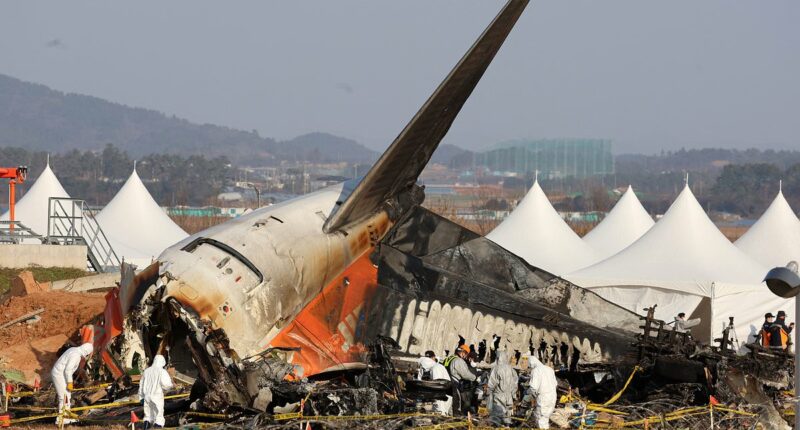Share this @internewscast.com
The past year has seen an apparent spike in commercial plane crashes, resulting in the loss of hundreds of lives.
Despite this, the total number of air travelers in 2025 is projected to reach 4.9 billion, with the demand for flights continuing to rise.
In December, 179 individuals lost their lives when a passenger plane veered off the runway and exploded while landing at Muan International Airport in South Korea, marking the nation’s worst air disaster.
Just four weeks later, on January 29, another unusual aviation tragedy occurred in Washington DC when a commercial plane carrying 28 star figure skaters collided with a military helicopter, resulting in the death of everyone on board.
February witnessed the third crash in as many months when a commuter jet flying from Minneapolis to Toronto unexpectedly burst into flames upon landing. Miraculously, everyone survived this incident, even though the plane flipped over.
In June, an Air India aircraft traveling from Ahmedabad to London Gatwick was airborne for just 32 seconds before it crashed into a university hospital building, causing the deaths of 241 individuals in the air and 19 on the ground, with one miraculous survivor.
Tonight, experts, witnesses, and the relatives of the victims appear in the new BBC documentary, Why Planes Crash: Aviation’s Deadly Year, to delve into what truly went wrong for air travel in 2025.
And, while each crash occurred for a complicated variety of different reasons, experts drew attention to some worrying trends.

The past year has seen an apparent spike in commercial plane crashes, resulting in the loss of hundreds of lives. Pictured: The wreckage of the Jeju Air Boeing 737 after it crashed at Muan International Airport on January 1
Dr Carla Dove, who works at the Smithsonian Institute in Washington, said: ‘The number of bird strikes reported each year is increasing. We don’t know the reason for this.’
Indeed, as the documentary highlighted, there were almost 20,000 bird aircraft collisions in the US in 2023 – a 14 per cent increase on the previous year.
Though the majority of these cause little to no noticeable damage, bird strikes have the potential to be fatal, with more than 90 per cent occurring during takeoff and landing.
The danger of bird strikes was seen clearly in the case of the Jeju Air flight in South Korea, which was returning from Bangkok in Thailand on December 29.
As the aircraft approached for landing after an uneventful flight, it was hit by an unexpected bird strike, with pilots declaring mayday and announcing they would attempt a ‘go-around’, meaning they would gain height and attempt landing again.
However, as it came in to land a second time, the plane’s landing gear wasn’t deployed, and it hit the runway at an astonishing estimated speed of around 200mph, with no means of slowing down.
Even at this point, the tragedy could have been avoided – but at the end of the runway was a barrier that ‘should not have been there’, according to experts speaking in the documentary.
Most barriers contain navigation equipment called a localiser, designed to break easily on impact, but at Muan Airport, there was a concrete structure inside, which reached halfway up the height of the plane.

Dr Carla Dove (pictured) from the Feather Identification Lab revealed how the number of bird strikes are increasing each year
According to installation guidance, the barrier should not be more than 7.5 centimetres above the ground. However, it had been installed on a mound that was two metres high.
‘In my opinion, the biggest reason this accident had such a high fatality rate, was the barrier at the end of the runway,’ Dr Sgayn Pruchnicki from the Centre of Aviation Studies explained.
‘That should not have been there, the aircraft should have been able to go off the runway into a protected area. That’s what caused the tremendous loss of life.’
‘If international standards had been followed as recommended, this tragedy would probably not have happened,’ Professor Kwon added.
In the documentary, experts raised concerns about the location of Muan International Airport itself.
The feathers of the birds found in the plane were from the Baikal teal duck, a type of migratory duck that flies in large flocks.
Dr Nial Moores, a conservation scientist, explained that the area surrounding the airport provided an attractive landscape for water birds, meaning any risk of bird strikes was already significantly heightened.
He said: ‘The majority of these birds have to commute in between where they sleep and where they feed.

An American Airlines flight from Wichita, Kansas collided midair with a military Black Hawk helicopter while on approach to Ronald Reagan Washington National Airport on January 29. Pictured: Fuselage from the plane is lifted from the Potomac River during recovery efforts
‘In the case of Muan, because you have tidal flat on one side, to the west of the runway, and then you have rice fields to the east of the runway, any bird that is trying to feed on the tidal flat will have to cross the runway.’
Since the accident, an investigation has been launched, and any concrete or steel barriers are set to be replaced by crushable material by 2026, as seen in airports in the UK, Germany, US, Spain and China.
By contrast, the collision of a military helicopter and a plane in mid-air in Washington DC four weeks later did not involve birds, and appeared to have occurred out of the blue.
Home to the busiest main runway in America with 1,800 planes taking off and landing every day, the airport is renowned for being closely monitored at all times.
But the eventual collision, in which 67 people died, including 28 people returning from a figure skating camp, and had no survivors, was the first fatal crash involving a commercial US plane in 16 years.
That particular night, on January 29, there was only a single air traffic controller on duty compared to the usual two people.
Paul Rinaldi, from the national air traffic controllers association, told the programme: ‘We failed’, while an initial report suggested staffing levels were ‘not normal for the time and volume of traffic’.
Close analysis of audio recordings from the helicopter just 20 seconds before the crash showed the vehicle may not have received vital instructions to pass by the jet.

Passengers leave a Delta Air Lines CRJ-900 jet after it crashed on landing at Toronto Pearson International Airport in Mississauga, Ontario, Canada February 17
They were told to ‘visually separate’ themselves just by eyesight, but one expert believes the helicopter pilots may have been looking at the wrong aircraft.
Data from the helicopter’s black box unveiled fatal design flaws in its flight path – and the fact it had been flying 24 metres above the limit.
Jeff Guzzetti, a retired aircraft accident investigator, said: ‘This accident was preventable. That helicopter route for years was laid out much too closely to the final approach course for runway 33.’
In the wake of the accident, the national transportation safety board released an analysis of flight data at Reagan National Airport across a three-year period, revealing 15,214 cases of commercial aircraft and helicopters flying within 120 metres of one another.
This meant that, one in 62 times an aircraft took off or landed at the airport, they were considered to be ‘too close’ to a helicopter.
In 85 of these cases, a helicopter passed within just 60 metres of a plane, putting both aircraft at a serious of a collision.
Mr Guzzetti added: ‘200 feet is less than a length of a football field. For aircraft that are moving faster than 100 miles an hour, 200 feet is *clicks* like that.’
In February, the world witnessed its third major crash in as many months when a Delta Connection Flight crashed in Toronto upon landing, flipping completely upside down.

Thick black smoke billowing from a residential area after Air India flight AI171 crashed in Ahmedabad on June 12, 2025
Hannah Krebs was onboard the flight from Minneapolis to Toronto.
The plane was dealing with freezing temperatures at the time and strong winds as it descended.
‘Once we started descending we started getting knocked around quite a bit by the wind but nothing felt really wrong to me other then it was quite a turbulent descent and that continued right up until we hit the ground,’ Hannah recalled.
When the plane touched down, footage suggested the landing gear collapsed and the plane flipped over.
Hannah added: ‘I was shocked that we survived, once we hit the ground, I could tell that it was way too hard. Everything started shifting this way.
‘Suddenly, before I knew it, we were upside down. I could hear the metal scraping on the ground as we skidded along.
‘And we skidded for what felt like forever and then when we stopped, it all got quiet.’
All 80 passengers and crew members survived the crash and managed to evacuate out of the plane quickly.
‘There was no stampeding, no rush, everyone just got into an orderly line and evacuated,’ Hannah said.
Finally, the documentary explored the case of the tragic Air India flight that was airborne for just 32 seconds of its 4,000 mile journey to London Gatwick.
The Boeing 787 dreamliner had 230 passengers at 12 crew onboard when it crashed into a university college hospital, also killing 19 people on the ground and creating the world’s deadliest disaster in a decade.
There was just one survivor: British national Vishwash Kumar Ramesh.
In mobile phone footage analysed, a propellor could be heard, thought to be an RAM air turbine to generate electricity, and suggesting a wider loss of power during the critical takeoff period.
A preliminary report suggested the cutoff switches were almost simultaneously flipped, starving the engines of fuel.
This meant the plane immediately began to lose thrust and sink down moments after setting off.
In the flight’s final moments, one pilot was heard on the cockpit voice recorder asking the other why he cut off the fuel. ‘The other pilot responded that he did not do so,’ the report by India’s Aircraft Accident Investigation Bureau (AAIB) said.
It did not identify which remarks were made by the flight’s captain and which by the first officer, nor which pilot immediately transmitted the distress call: ‘Thrust not achieved… falling… Mayday! Mayday! Mayday!’
However, a full transcript of the conversation between pilots is yet to be released and is expected in the final report.
This World: Why Planes Crash, Aviation’s Deadly Year, is set to air on October 13 at 8pm on BBC One.
















